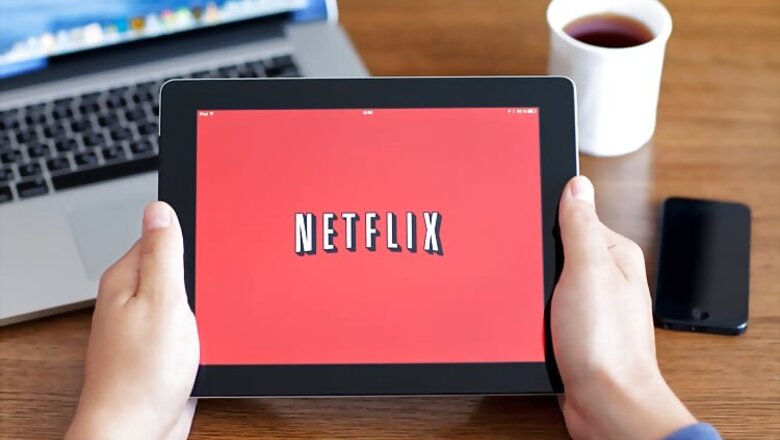
views
Founded in 1997 offering a DVD-mailing service for a flat rate, Netflix is the leading website streaming different genres of moving images (movies, series, documentaries, soaps, serials, dramas, comedy, anime, zombie shows, and cartoons) but it is accessible only for paid subscribers unlike YouTube. It took almost five years for Netflix to reach a sustainable model; and started streaming only in 2007 in the US. It has over 70 million subscribers in more than 100 countries watching more than 125 million hours of content every day.
With its hunch that Internet TV will replace linear television, it made its presence in India and aims to go global by 2017.
Netflix offers a choice to watch on two screens at the same time and its subscribers can watch as much as they want with a choice to play, pause and resume the program without commercials.
Unlike China, India welcomes Netflix
Netflix drew the attention of Indian media because it is American, and it will also 'invest little money' and will 'take out more money'; and could enforce its local competitors to give quality service and wide-range of content for viewers.
Netflix is not free. To access its content one can choose from three price plans of Rs 500, Rs 650 and Rs 800 per month. As a taster to the Internet-abundant Indians, there is a free trial for a month but in order to avail this free service one ought to enter their bank details (but you can cancel it later). Payment information (debit or credit card details) is mandatory; so is: I'm 18.
There are video-streaming websites in India such as the Box TV (English, Hindi, Tamil, Telugu), HotStar (Hindi & regional movies on which some of them are free to watch); ErosNow (enables the viewer to watch some free content, and premium access for less than Rs 100 to its unlimited movies and TV shows without advertisements but with subtitles); and SonyLiv (sports to shows, movies to serials).
But Netflix can offer a digital Indian the access to American entertainment content otherwise not available on any other platform.
The English-speaking population in India is not meager though about 10% of the total population. Interestingly, for most of them there is also a mother tongue or partial-tongue (Hinglish, Benglish, Telugish, Tamilish…). Ranbir Kapoor-the A-star of Bollywood and of third-generation Kapoor family-spoke mostly in English at home until he decided to plunge into Indian cinema (and he is making a splash).
The 125 million English-speaking Indians is a huge market for Netflix to capture, even if it can get couple of millions.
After the US, India has the largest number of English speakers and its number is expected to quadruple (utility of English language: employment & opportunities & social mobility).
Netflix: popularising Internet TV & hastening TV's death
Television aka the 'small screen' has hastened the death of indie cinema halls aka the 'silver screen' and to some extent the radio. Its time has come. These Internet-enabled devices are hastening the death of television unless television adopts itself to mobile portability. Netflix notes that "the linear TV experience, where channels present programs only at particular times on non-portable screens with complicated remote controls" will be replaced by Internet TV.
With technological advances in portable devices (mobile phones and tablet computers), penetration of Internet connectivity, reliability, with smart TVs in the market (the platform of 'screen' convergence), availability of content to customise including for binge watching of a serial will make the Internet TV popular.
To catch up with unfolding technological advances, to be on the cusp of innovation and visualization, Netlix is expected 'to spend over $700 million on technology & development in 2016'. This makes the website bulletproofed from its competitors (existing and incoming).
What makes Netflix unique is that it also sources its content such as season one 'House of Cards' and the freedom to watch wherever and whenever. It believes it has a major advantage over our linear competitors when it comes to launching a series or a film. "Linear networks need to attract an audience on a given night at a given time. We can be much more flexible. Because each show on Netflix is not competing for scarce prime-time slots like on linear TV, a show that is taking a long time to find its audience is one we can keep nurturing. This allows us to prudently commit to a whole season, rather than just a pilot episode."
CNN of Internet TV: localized Internet TVs will emerge
Cable News Network (CNN) is the world's first 24 hours news channel launched in 1980, and influenced every country to have one.
Netflix has changed (in the US) and is changing the viewers' experience meaning shifting them from television to Internet TV with its innovative methods from making the content available to audience anytime anywhere and giving plethora of content to choose.
CNN enabled mushrooming of television news & current affairs channels across the world, and Netflix has done that for Internet TV since 2007.
There are bound to be many more Internet TVs in vernacular languages. Because language is the defining trait of a culture and people would prefer to consume entertainment in their mother tongue unless one is culturally uprooted, and deliberately disconnected (out of choice).
Impact of Netflix on Digital India
Netflix's US' market is almost saturated. It ought to go global. India already has about 800 television channels: ranging from cooking to devotion, movies to news & current affairs in English and local languages.
But Netflix can satiate the thirst of globalised and globalising (digitised) Indians for entertainment in bringing Hollywood and America's culture (imperialism?) closer to their eyes.
Netflix releases Internet Service Provider (ISP) Speed Index periodically in its countries of operation, and Indian ISPs will come under its scanner (external but impartial?).
With more to watch online and offline, will India become as obese as the US? Or will (digital) yoga overcome the obesity?
(Kovuuri G. Reddy teaches journalism and media at the Department of Journalism & Mass Communication, AIGS, Acharya Institutes, Bangalore University. He is the author of 'Handbook of Journalism and Media: India, Bharat, Hindustan'.)














Comments
0 comment